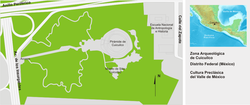Other investigations
The prehispanic settlement and its surroundings, upon being covered by lava, were sealed and preserved. Archaeological materials above the lava were affected differently during the last 2000 years. [7]
The lava flow sealed off the northern shore of the lake and appears to have created a marshy peat deposit in the eastern section. Multiple layers of volcanic ash from Xitle and possibly from Popocatepetl have been detected in the peat. [1]
It has also been suggested that other volcanoes in the area may have played a role.
"No geological evidence under the Xitle flow suggests an earlier eruption, but another monogenetic volcano, Chichinautzin, was also active in the area prior to Xitle and is believed to have had a similarly large flow and to have resulted in similar ecological changes. The Yololica volcano also erupted at about the same time as Xitle, and its lava flows are only a few kilometers from Cuicuilco". [12]
During Byron Cummings' 1922–1925 exploration, ceramics were found from phases preceding the eruption. Eduardo Noguera (1939) excavated burials in the proximity of the pyramidal sector known as Cuicuilco A, corresponding to the preclassical archaeological site. In 1957, investigations by Heiser and Bennyhoff provided relevant information to refine the chronological sequence of the main building basement (cf. Schávelzon, 1983) [7]
Between 1966 and 1968, important complexes of architectural structures were found as well as a series of conical formations, a group called Cuicuilco B, where more than 300,000 ceramic pots were rescued (Müller, 1990). Based on analysis of archaeological ceramics of Cuicuilco B, Florence Müller determined that the occupation of the settlement continued after the Xitle eruption, during the Classical, Epiclassical, postclassical periods until the Spanish conquest, even though the importance of the site as well as the number of inhabitants dropped radically. [7]
In 1990, in the sector known as Cuicuilco C, Rodríguez identified predominant preclassical ceramic materials, as well as, to a lesser extent, pots from later periods, including colonial and modern (Rodriguez, 1994). [7]
Stratigraphy has determined that, after the Xitle eruption, materials were deposited on a layer of lava cushions associated with a body of water, which demonstrate the presence of settlements or villages from approximately 200 to 950 CE, according to the preliminary analysis of ceramic layer [7]
Features of archaeological materials allow inferring the context of the natural and cultural training processes. Inhabitants discarded vases and fragments in the vicinity of the body of water, and many pots were trapped in the lava, especially domestic pieces such as pans, pots, pitchers, dishes, boxes and comales, even if it does not preclude the possibility that at the end of the life of these vessels, they were simply thrown into the water, considered as trash. On the other hand, the presence of braziers fragments, miniature pieces and Tlaloc vases indicates that these were thrown into the water as offerings as part of rites similar to those recorded by Spanish chroniclers as Sahagún (1989) and Duran (1967) in the twin cities of Tenochtitlan and Tlatelolco as well as in other settlements in late postclassical Mexico. [7]
Many ceramic materials identified in the preliminary analysis correspond to phases of Teotihuacan's apogee during the classical period (Tlamimilolpa and Xolalpan phases), between 200 and 650 CE. According to recently adjusted chronology based on radiocarbon dating (cf. Rattray, 1991); predominant types are temporarily located in the epiclassical period, 650-950 CE, Coyotlatelco tradition (cf. Rattray, 1966), and are contemporaneous with the Tula Chico occupation (cf. Cobean, 1990), as well as other important settlements in the Valley of Mexico, as Cerro de la Estrella and Azcapotzalco (altepetl). There are also materials, although in low percentages, whose production and consumption starts in the epiclassical (based recent research made in the Tula region) but have been associated with the Tula apogee. According to ethno-historical sources and some radiocarbon dating, it is located chronologically between 950 and 1150 CE. (cf. Cobean, 1990) [7]
These archaeological materials indicate strong social interaction between the Valley of Mexico and other regions under the hegemonic power of Teotihuacan, as well as the conformation of sociopolitical units after the decline of said Empire, also as evidence of socio-economic aspects associated with the emergence of the Toltec State. [7]
It is a restricted area where deposits were affected by activities of the 20th century, fragments found of Aztec ceramics from the end of the late postclassical, materials of the colonial period (native and Spaniards) as well as 19th-century European fine earthenware. This material provides evidence of a settlement or village in Cuicuilco from the Tepaneca-Aztec empire, before the Spaniards' arrival, continuing the occupation of land owners such as Bernal Díaz del Castillo and other. [7]

















